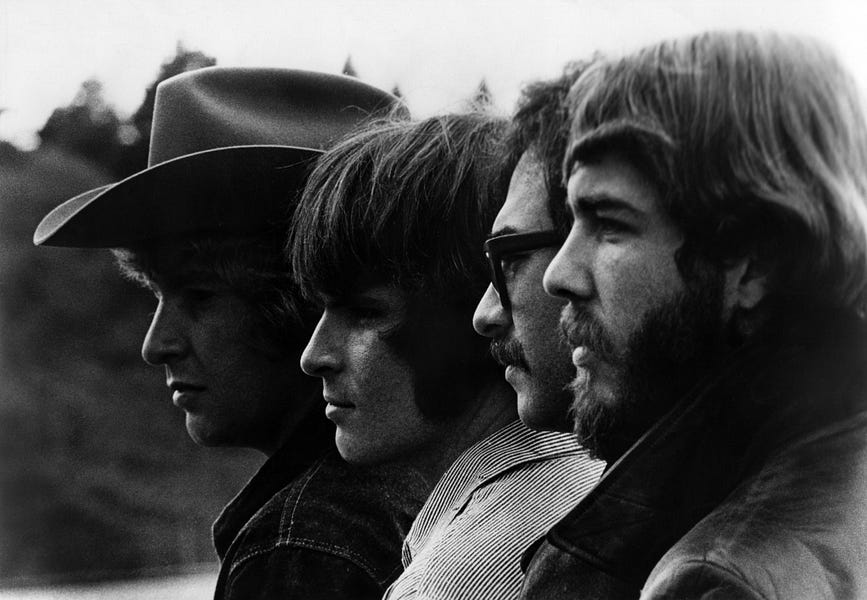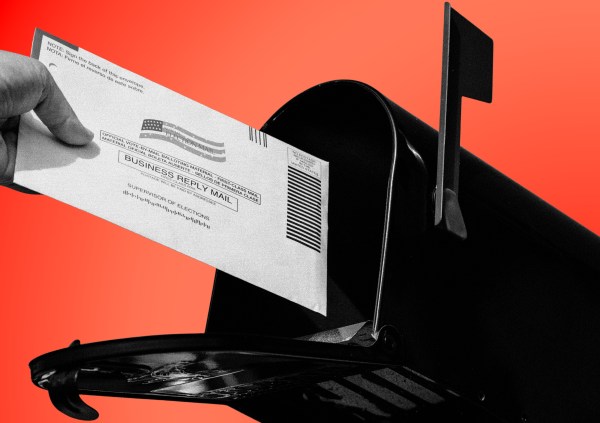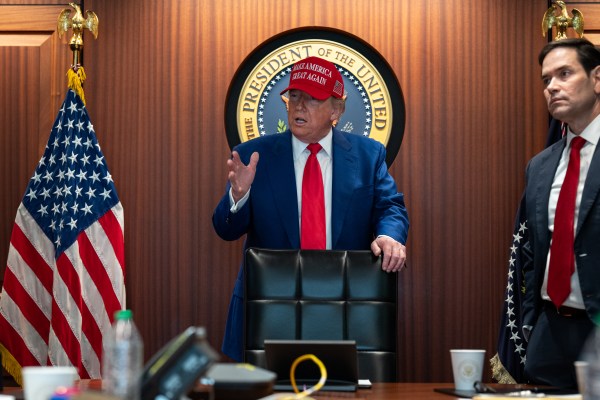In his speech inducting Creedence Clearwater Revival into the Rock & Roll Hall of Fame, Bruce Springsteen got to the heart of what makes the band so special. Their music was “severe; precise; lyrically spare and beautiful,” he said. Written in “an American tradition,” their songs seemed to be written for “waylaid Tom Sawyers and Huck Finns.” He recalled how, when starting out himself, he would often play their hits in a local bar, and watch the songs establish a brief and beautiful camaraderie among the diverse patrons: “rough kids just out of high school, who hadn’t been snatched up by the draft yet; truck drivers heading home south through the Jersey pines … and a mixture of college and working girls, women with bouffant hairdos, and a small but steady hippie contingent.” They all loved CCR.
In fact, there was a brief moment when it looked like Creedence might eclipse the Beatles. The four boys from California’s Bay Area—lead singer John Fogerty, his brother Tom on rhythm guitar, and their junior high school classmates Stu Cook and Doug “Cosmo” Clifford on bass and drums, respectively—had played together since 1958. But they hit gold a decade later with songs such as “Suzie Q,” “Proud Mary” and “Green River,” and were soon performing before immense crowds at mega-concerts, including Woodstock. Their records outsold the Beatles, who broke up just four days before Creedence took the stage at London’s Royal Albert Hall on April 14, 1970, as part of their first European tour.
Then it all disappeared. Tom quit in 1971, and simmering anger between the remaining members made collaboration impossible. A year later, their final album earned a damning review from Rolling Stone’s Jon Landau, who called it “the worst album I have ever heard from a major rock band.” Six months after that, CCR was kaput. John Fogerty refused even to be in the same studio with his former collaborators—a feud that continues to this day.
Creedence did virtually no merchandizing, and its amateurish marketing was overseen almost entirely by John. As a consequence, almost nothing remains of them except the music. That’s why the simultaneous release of John Lingan’s book A Song for Everyone: The Story of Creedence Clearwater Revival and Netflix’s rockumentary Travelin’ Band: Creedence Clearwater Revival at Albert Hall are so welcome. Together they help recapture the magic of the biggest rock group ever to vanish into thin air.
They began as Tommy Fogerty and the Blue Velvets, because Tom, four years older than the others, already had earned a reputation as a singer. When the members decided to commit themselves fully to the band, Tom donated his entire savings account—$1,250—to finance their efforts, while also ceding his role as singer to his younger brother, because, as he says in the Netflix film, he recognized that John had “one of the most unique voices” in rock ‘n’ roll, “right up there with Ray Charles and Van Morrison.” When they signed with a small label called Fantasy Records, the company renamed them the Golliwogs and forced them to wear ludicrous costumes à la the Monkees. In 1967, they finally refused, and took a new name, inspired in part by a beer commercial. They developed a unique style that fused John’s gritty, blues-inspired voice with ragged but disciplined guitar licks that drew upon blues and rockabilly.
Fantasy’s management never figured out how to market CCR—and one of the themes Lingan conveys well is that the band was basically a family-owned small business; a Bay Area start-up like the software companies to come. Except for Stu, whose father was a successful lawyer, the quartet worked their way up from nothing, by sheer determination and obsession with the music they adored. They began as amateurs, and largely made it up as they went: Lacking a publicity manager, John would even send reporters weekly postcards announcing the band’s concert dates. That Creedence was such a labor of love goes far to explain the half-century of bitterness that followed their breakup.
Fifty years later, parsing their grudges would be tedious and dull—it certainly marred John’s 2015 memoir, Fortunate Son—and Lingan wisely chooses instead to focus on putting Creedence into historical and cultural perspective. By juxtaposing the band’s career with the period’s intense political and social clashes, and comparing its work with the era’s musical, literary, and cinematic output, he seeks to capture how CCR reflects 1960s youth culture. And he is such a superb writer that he almost succeeds. His book is lovingly—and at times beautifully—written, particularly in his smart and evocative analyses of Creedence’s distinctive sound and the influences that combined in John’s songwriting. This alone makes the book a must for fans of ‘60s music.
But in the end, Lingan’s “life and times” approach fails, because the most unique element of Creedence’s career—and the key to their cross-cultural, cross-generational appeal—lies in the fact that they do not embody the 1960s counterculture. They were in, but not of, the hippie era; loathing the “tune in, turn on, drop out” mindset, they never embraced the drugs, violence, or faddish artistic or political slogans that marked the time. Although Lingan spends many pages placing Creedence alongside contemporaneous crises such as the Vietnam War, the Berkeley Free Speech Movement, and the riots that followed Martin Luther King’s assassination, he is repeatedly forced to confess that the events he narrates made little detectable impact on their music. In one chapter, for example, he describes in moving detail the plight of young Vietnam draftees “who were being sent across the world at gunpoint despite crumbling support for their purpose or mission,” and remarks that the foursome“were aware that their songs might be the last live music that some members of their audience might ever hear”—only to admit a few pages later that John “wasn’t writing songs about” these subjects, and that his bandmates “weren’t marchers by temperament.” Indeed, when Doug and John’s draft numbers came up, they didn’t refuse: They served.
Creedence was by no means a “conservative” group (whatever that might mean)—they even donated a boat to help the American Indian Movement members who occupied Alcatraz in 1969 obtain needed supplies. But they didn’t approach their music as propaganda. “Run Through The Jungle” isn’t even about Vietnam—John meant it as a subtle call for gun control. Creedence’s entire catalog contains only three truly political songs—“Fortunate Son,” “Effigy,” and “Don’t Look Now”—and even these cross ideological lines. The first comments on the injustice of special privileges for the wealthy and well-connected. The second prophesies the horrors of civil war. “Don’t Look Now,” the best written of the three, takes a step back to comment on how politicians and voters alike try to avoid responsibility for their political demands:
“Who will make the shoes for your feet?
Who will make the clothes that you wear?
Who’ll take the promise that you don’t have to keep?
Don’t look now, it ain’t you or me.”
That’s a reality the truck drivers, college girls, and high school grads for whom Springsteen later performed could all acknowledge. But, as Lingan admits, such a song “wasn’t a statement. Creedence didn’t make those.” “We are interested in social causes,” Stu said in an interview at the time, “but we aren’t willing to go far left to prove it.”
That apartness from the counterculture was evident in their sound as well as their professionalism. Backstage at the Fillmore West one evening, a drunk Janis Joplin said she loved them because, “You’re never playing that stupid psychedelic shit!” And it was true: Notwithstanding some far-out touches on their first album, Creedence’s distinctive style had more to do with Little Richard and Carl Perkins than with the LSD and consciousness-warping of Jefferson Airplane or the Grateful Dead. They scorned drugs, particularly after attending one Dead concert at which that band’s stoned members played so badly that John, Tom, Doug, and Stu vowed to perform only while sober, and never to use anything stronger than marijuana. Creedence, writes Lingan, “may have been the only young men scared straight by their time in the [San Francisco] ballroom scene.” Indeed, John was downright puritanical by rock-star standards; shocked by his bandmates’ carousing on tour, he later wrote confessed that he was “not the guy who got into music to get girls—I was there for the music.” That helped earn Creedence a reputation for squareness, as did the fact that they always showed up on time and honored their contracts. They had few friends among their fellow rockers; the Dead, in particular, became their artistic nemesis. They felt closer to producer Bill Graham. “It reinforced the band’s way of thinking to see that they shared it with the most successful promoter alive,” Lingan explains.
Indeed, Creedence was among the hardest working and most businesslike groups in history. They practiced every day, on a schedule so grueling that Doug once lost his temper and called their studio “a goddamn factory!”—which gave them a title for their 1970 album Cosmo’s Factory. As band leader, John’s standards were almost cruelly high. He decided his team’s backup vocals on “Proud Mary” were insufficiently harmonious, and overdubbed his own voice instead, without telling them. He thought their Woodstock performance subpar, and he refused to let it be included in the film Woodstock or to sell the audio recording until 2019. Indeed, except for a 1970 TV special that was broadcast once and then destroyed, the new Netflix documentary marks the first Creedence concert video ever officially released. And it shows the foursome at the height of their powers, blazing through a setlist of songs that have become modern classics, from “Bad Moon Rising” to “Born on the Bayou” to “The Midnight Special.” The presentation is lean and clean—the band’s trademark lack of affectation is on full display—and the audience was so delighted that, as the film’s narrator Jeff Bridges observes, it gave Creedence a 15-minute standing ovation.
What Bridges doesn’t mention is that the reason they cheered so long is because they wanted an encore, and John refused. Arbitrarily deciding that encores are phony, he proclaimed that the band would no longer do them, and the other three went along with it, although Doug was so angry about it that he overturned a table backstage. (Accounts differ over whether John was sitting on it at the time.) As Lingan observes, John’s domineering perfectionism was hard enough for the other three to swallow in the studio, where he wrote all the songs, played all the leads, and sang all the vocals—but it was especially galling on tour, because concerts were their only opportunity to show off their work to the audience. In his memoir, John admits to monopolizing the band, but claims it was necessitated by the others’ laziness and incompetence. The Netflix documentary and the Woodstock album prove how unjust that accusation is.
On the other hand, it must be conceded that John’s fastidiousness resulted in songs that are now as firmly fixed in American culture as the poetry of Walt Whitman or the films of George Lucas. What explains that impact is the way those songs draw on elements deeper than passing fashions or political concerns. The instrumentation has a no-frills grit and bounce that combines the best elements of indigenous American music. If the lyrics have any ideological core, it lies in what Lingan calls a “single-minded idea of heroism built on individual resistance to outside restriction”—which is to say, plain Americanness. “Proud Mary” is about Mark Twain, not Timothy Leary or Herbert Marcuse. Songs like “Green River,” “Up Around the Bend,” and “Born on the Bayou” evoke an imaginary Huck Finn experience, where a boy might fish, play with his hound dogs, and dance with barefoot girls in the moonlight, without having to answer to outside authority. John’s music grew from a mythos perfectly symbolized by the hillbilly flannel he wore, and still wears, on stage—and he is surely the only ‘60s rocker to cite Stephen Foster as a major songwriting influence.
“I’m not trying to polarize hippies against their parents,” he told one interviewer. “My concept of what music is supposed to be [is that it] shouldn’t do that. It should unite, as corny as that is.” Yet he also strove to avoid clichés and anodyne sentiments. “I don’t appeal to basic motivations,” he says in the Netflix film. “I don’t start, you know, ‘Hey all you hippies, join together and let’s smoke dope,’ you know? I mean, people are gonna dig that—a certain element of society—but I don’t want them digging it for that. I want them to look a little further…. ‘Who’ll Stop the Rain,’ and some of the others, too, but especially that one, I tried to stay away from, ‘Hey, he’s a left-wing radical crazy,’ or ‘He’s a super-Bircher,’ you know, because both sides can take it, because both sides can take it and use it as their own rallying cry. Same with ‘Fortunate Son,’ really.”
Simply put, the band’s unique success came from creating music that embodies a vision of the American character without being superficial. Thus Lingan’s claims that their songs “captured the anger of watching the world go wrong” and articulated “their age group’s increasing sense of betrayal and disappointment” are weirdly off-key. One reason he makes this error seems to be that he accepts the stereotypical narrative of the ‘60s, according to which the decade was a clash between idealistic youth, striving to vindicate the cries of conscience, and their stiff-shirt, warmongering elders. He seems unable or unwilling to imagine why anybody would be turned off by blithe talk of abandoning the war against communist imperialism, or oppose the Great Society, or vote for Nixon and Reagan. Such superficiality fails to answer—or even ask—why, both then and now, conservatives could love Creedence as much as liberals do. Viewing the ‘60s through a partisan lens leaves readers with only half of the story of their charm. “‘Political’ always throws me,” John once told Rolling Stone, “because in this country it means Democrat, Republican, or none of the above. I’ve been all three in my voting life.” He summarized his own politics as “Be responsible for yourself and help your fellow man. Don’t be a burden. Live and let live. Don’t try to control everybody.”
Where Lingan’s panorama of the ‘60s is more effective is in highlighting how the band’s career paralleled the self-destructive trajectory of that time. Creedence’s internal quarrels accelerated just as Cold War idealism began to crumble, civil rights protests degenerated into riots and assassinations, and Americans grew increasingly cynical and embittered. As the decade ended, artists began destroying themselves. A year after Woodstock, a drunk Jim Morrison burst into Creedence’s hotel suite and passed out on their pool table; when they left the next morning, he was still unconscious. Jimi Hendrix was found dead of an overdose days later. He was followed by Janis Joplin in October. “They were all only twenty-seven years old,” Lingan notes, “which was still older than every member of Creedence except Tom.” In December, security guards at the Rolling Stones’ Altamont Concert stabbed a man to death during a song. Stu was in the audience, and was almost trampled by the rioting crowd. The Age of Aquarius was becoming the Ageof Dionysus, the Greek god of ecstatic intoxication whom the other gods tore apart and devoured. (Athena salvaged only his heart.)
In such an environment, Creedence’s aesthetic of rockabilly nostalgia and downhome self-reliance–what Lingan calls “feel good songs for feel bad times”–couldn’t hope to compete. When they finally broke up in 1972, it wasn’t because of drugs: Artistic, financial, and professional clashes had simply wrecked the fun. John showed up at Stu’s house one day and said, “I don’t want to do this anymore.” “The band didn’t explode,” Lingan concludes. “It dissolved.” Lawsuits consumed the next decade, and an embittered John Fogerty would even refuse to play Creedence songs at his concerts.
Yet while the band’s story ends in heartbreak, its music remains, and with it the vision of freedom and escape it so vividly expresses. In fact, the best epitaph for the band was written by Tom, in the lyrics to a little-known cut on his 1974 solo album, Zephyr National. Inspired in part by Don McLean’s recently released “American Pie,” it was titled “Joyful Resurrection,” and it featured Stu and Doug in supporting roles. Its poignant lyrics, infused with sly references to CCR’s history (“Resurrection” is a play on “Revival”) reflected on their loss of innocence—and that of their audience—while still cherishing the naive dream they’d so loved:
“So you think that the music died with Holly?
Well let me tell you people that ain’t right.
Cause a boy named Valens sent us all to Del-Fi
And a rocking voice to carry in the night….
Came the dawn and the sun was shining brightly,
For the four boys from the county came to play.
But the best laid plans go funny,
And the evil clouds of darkness had their way”
Have you heard of the joyful resurrection?
A way to bring your mind back from the Dead…
The history of Creedence Clearwater Revival is bittersweet, even tragic in some ways—but it’s also a story of triumph and, as Tom would have it, of joy. The band’s rugged sound is uplifting and delightful in its rough simplicity, and for every bad moon and graveyard train their lyrics offer, they also serve up an image of freedom, authenticity, and a place up around the bend where there’s an ear for what you say. Their music is now woven into the national soul, and its very timelessness makes it is available to each new generation to claim as its own. Lingan and Netflix have given us a precious opportunity to reconnect with their rare artistry.








Please note that we at The Dispatch hold ourselves, our work, and our commenters to a higher standard than other places on the internet. We welcome comments that foster genuine debate or discussion—including comments critical of us or our work—but responses that include ad hominem attacks on fellow Dispatch members or are intended to stoke fear and anger may be moderated.
With your membership, you only have the ability to comment on The Morning Dispatch articles. Consider upgrading to join the conversation everywhere.